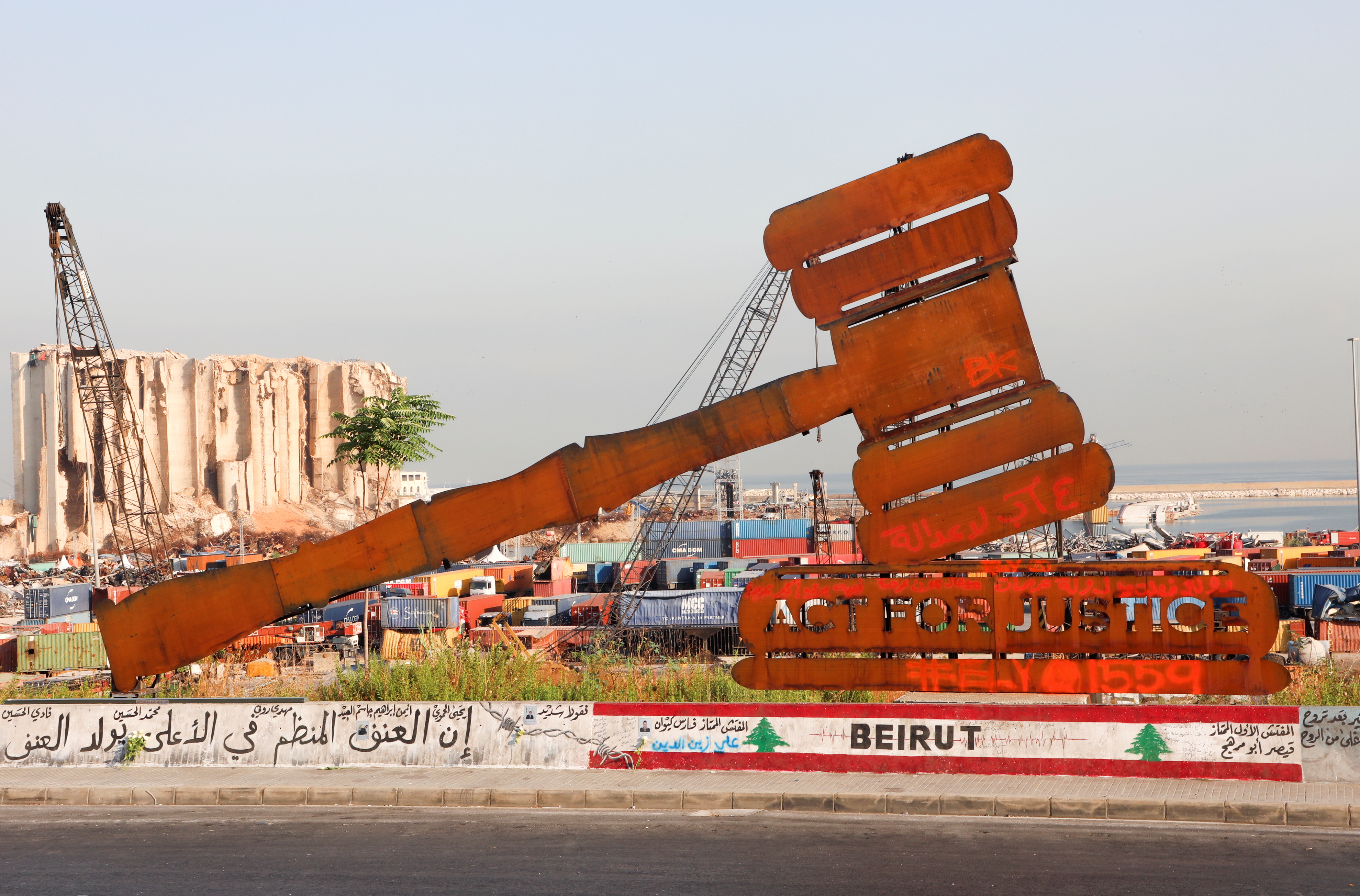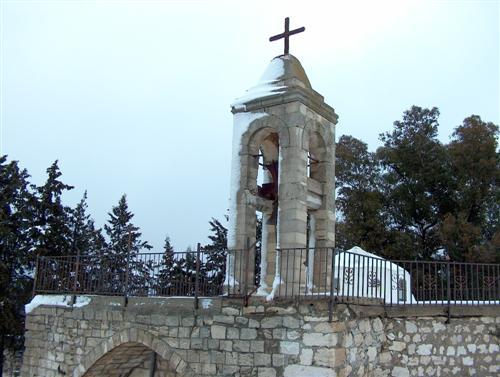
A justice symbol monument is seen near the grain silo damaged during last year's Beirut port blast as Lebanon marks the one-year anniversary of Beirut port explosion, in Beirut, Lebanon August 4, 2021. REUTERS/Mohamed Azakir
By By Tamara Qiblawi -- cnn -- It's been a year since one of the world's largest ever non-nuclear explosions ripped through Lebanon's capital, killing more than 200 people. On any given day in Beirut's worst-affected neighborhoods, theories about the explosion still circulate. No two stories of human tragedy are alike, and most interactions between people here end not with a goodbye, but with an invocation that Lebanon's ruling elite be toppled. The political class is, overwhelmingly, blamed for the disaster. At just after 6 p.m. on August 4, 2020, hundreds of metric tons of ammonium nitrate ignited, sparking the massive blast in the city's port. The industrial chemicals had been improperly stored there for years due to the failure to act by successive governments and lawmakers across the political divide. That much is clear. But for people across Lebanon, there are still many unanswered questions about what led to the tragedy, and there has been no sense of closure in the 12 months since the explosion.
Here's what we still don't know.
What triggered the blast?
Because of the many inquiries by journalists and rights groups over the past year, we know that the ammonium nitrate — stored alongside fireworks in a poorly maintained warehouse — was a disaster waiting to happen. Six urgent letters sent by customs officials since 2014 — the year the material was unloaded at the port under mysterious circumstances — had alerted the authorities to the danger posed by the chemicals. One was written by a port official in May 2020, just months before the blast. "This substance, if ignited, will lead to a large explosion, and its outcome will almost obliterate the port of Beirut. If the substance were exposed to any kind of theft, the thief would be able to use this substance to build explosives," warned the document, which was obtained by CNN after the incident. Beirut's port is just 100 meters from some of the city's most densely-populated neighborhoods. The blast destroyed not only a large part of the port, but also left swathes of the city in tatters. The damage was estimated at between $3.8 and $4.6 billion. It is clear that successive leaders — four governments and three prime ministers — either would have or should have known about the threat posed by the material, and that little was done to address the danger.
But what is far from clear, 12 months on, is what ignited the ammonium nitrate. According to a report by Human Rights Watch, Tarek Bitar, the judge charged with investigating the explosion, is looking into several theories. One is that sparks from welding works that day caused a fire in hangar 12, the warehouse where the chemical was being stored. Another is that an Israeli strike was the catalyst, though Lebanese aviation officials reported that local radar systems did not detect military aircraft over Lebanese airspace in the hour or so before the blast, Israeli officials have denied any involvement, and Bitar himself has said the Israel theory was highly unlikely, according to HRW's report. Bitar is also exploring the theory that the explosion was an intentional act, according to HRW. A huge fire broke out Thursday at the Port of Beirut, triggering panic among residents traumatized by last month's massive explosion that killed and injured thousands of people.Huge fire breaks out at Beirut port a month after explosion "Speculation that Hezbollah may have wanted to destroy the ammonium nitrate at the port supposedly to hide that some of the ammonium nitrate in the stockpile had been used by Hezbollah's ally Bashar al-Assad in Syria to produce barrel bombs increased as reporting emerged regarding the connection between the cargo owners and individuals sanctioned by the U.S. for alleged links to Assad," the report said, referring to an investigative report by local journalist Firas Hatoum.


People carry photographs of victims of last year's devastating explosion, in a march in Beirut demanding accountability and justice, Aug. 4, 2021

Wounded people are evacuated after a massive explosion in the port of Beirut, Aug. 4, 2020. A year later, families of the victims are consumed with winning justice for their loved ones and punishing Lebanon's political elite, blamed for causing the disaster through corruption and neglect.
By csmonitor.com -- By Scott Peterson -- No Lebanese citizen who felt the shock wave of one of the largest non-nuclear blasts in history will ever forget its destructive power – or that it signaled a new low of negligence and corruption for Lebanon’s political elite. The explosion a year ago of ammonium nitrate, poorly stored in Beirut’s port, destroyed swaths of the capital and enveloped the city in a shroud of trauma that left more than 200 dead and 300,000 homeless. Lebanon marked the grim anniversary Wednesday with a day of mourning, and protests in Beirut demanding justice. The Beirut port blast exemplified the government ineptitude that had fueled Lebanon’s protest movement. In response, a resilient and energized civil society has taken charge of the rebuilding effort. Yet even as Lebanon began last year to grope through one of its darkest moments, volunteers came from every corner of the country to help.
As if by reflex, Lebanon’s civil society swung into action, its skills well practiced after a 15-year civil war, multiple armed conflicts, a collapsed economy, the absorption of 1.5 million Syrian refugees, and the pandemic – all crises created or made worse by chronic political dysfunction. The outpouring of public support was as unprecedented as the scale of ruin. The website of the charity Offre Joie (Joy of Giving), for example, which for years had helped Lebanese rebuild from war and violence when government was absent, crashed as more than 6,000 volunteers rushed to sign up. The result, one year later, is the emergence of a vigorous and competent civil society movement that has seized the reins of rebuilding and convinced donors to bypass corrupt government institutions. And a unique mechanism called the Reform, Recovery and Reconstruction Framework (3RF) – run jointly under the United Nations, European Union, and World Bank – has made its demands for accountability and reform heard at the highest level and has placed activists carrying out the recovery across the table from government officials.

by artnet.com -- Sarah Cascone -- A year after the deadly explosion in Beirut that shattered the city, a new sculpture commemorating the victims of the tragedy has gone up. It’s a work meant to heal—but in the charged atmosphere of crisis-wracked Lebanon, the memorial is also being met by a wave of fierce criticism. The towering sculpture, by Lebanese artist Nadim Karam, was unveiled on August 2 at the site of the explosion. Standing 82 feet tall and weighing in at 35 tons, The Gesture (2021) is made of steel salvaged from Beirut’s port after the blast. The piece takes the form of a giant holding out a flower. Karam, an accomplished figure in local public art, intended the gesture to symbolize “an act of memory and a gesture towards the immensity of sadness that marks the people of Beirut,” according to a statement. “It is a giant made of ashes, traces from the explosions, scars of the city, that still exist everywhere in Beirut,” Karam told Arab News. “The work represents the scars of the people that still have not healed. This figure is every single one of us and a reminder that we are the living energy of Beirut.”
The Gesture will ultimately also incorporate a water feature and a light installation in time for Lebanon’s national day of mourning on August 4. But the response to the work has been divided. Some argue that the wounds of the attack—which killed more than 200, injured at least 7,000, and destroyed large portions of the city, leaving more than 300,000 without homes—are still too raw for a public memorial, especially on the site itself. “That’s a shameful gesture,” Mazen Chehab, a local creative director, wrote on Instagram, according to the National. “Nothing should be done with the port until those responsible for the explosion are heavily sanctioned.” “The killers have complete impunity and we are already pretending something is in the past and we are trying to transcend it through art,” filmmaker Rawan Nassif told Reuters. “I feel this is a crime scene that can’t be touched yet, and it has to be investigated.” Top officials have thus far not been investigated for the devastating blast, though Lebanese parliament indicated on July 29 that they will no longer have immunity.
by reuters By Maha El Dahan, Editing by Timothy Heritage -- -- A report released by Human Rights Watch on Tuesday concluded there was strong evidence to suggest some Lebanese officials knew about and tacitly accepted the lethal risks posed by ammonium nitrate stored at Beirut port before the fatal blast there on Aug. 4 last year. HRW called for a U.N. investigation into the explosion, which was caused by the chemicals stored unsafely at the port for years and killed more than 200 people, injured thousands and destroyed swathes of Lebanon’s capital. The report by the international rights watchdog contained over 700 pages of findings and documents. Its investigation also concluded there was evidence that multiple Lebanese authorities were criminally negligent under Lebanese law.
HRW said President Michel Aoun, caretaker Prime Minister Hassan Diab, director general of state security Tony Saliba and other former ministers wanted for questioning by judge Bitar, had failed to take action to protect the general public despite having been informed of the risks. The presidential palace offered no comment. Saliba said his agency did all it could within its legal remit, filing legal reports to warn officials, and had an office open at the port only months before the blast. There was no immediate response from Diab. Aoun said on Friday he was ready to testify and that no one was above the law. HRW based its report on official documents it reviewed and on multiple interviews with top officials including the president, the caretaker prime minister and the head of the country’s state security.
Khazen History


Historical Feature:
Churches and Monasteries of the Khazen family

St. Anthony of Padua Church in Ballouneh
Mar Abda Church in Bakaatit Kanaan
Saint Michael Church in Bkaatouta
Saint Therese Church in Qolayaat
Saint Simeon Stylites (مار سمعان العامودي) Church In Ajaltoun
Virgin Mary Church (سيدة المعونات) in Sheilé
Assumption of Mary Church in Ballouneh
1 - The sword of the Maronite Prince
2 - LES KHAZEN CONSULS DE FRANCE
3 - LES MARONITES & LES KHAZEN
4 - LES MAAN & LES KHAZEN
5 - ORIGINE DE LA FAMILLE
Population Movements to Keserwan - The Khazens and The Maans
ما جاء عن الثورة في المقاطعة الكسروانية
ثورة أهالي كسروان على المشايخ الخوازنة وأسبابها
Origins of the "Prince of Maronite" Title
Growing diversity: the Khazin sheiks and the clergy in the first decades of the 18th century
Historical Members:
Barbar Beik El Khazen [English]
Patriach Toubia Kaiss El Khazen(Biography & Life Part1 Part2) (Arabic)
Patriach Youssef Dargham El Khazen (Cont'd)
Cheikh Bishara Jafal El Khazen
Patriarch Youssef Raji El Khazen
The Martyrs Cheikh Philippe & Cheikh Farid El Khazen
Cheikh Nawfal El Khazen (Consul De France)
Cheikh Hossun El Khazen (Consul De France)
Cheikh Abou-Nawfal El Khazen (Consul De France)
Cheikh Francis Abee Nader & his son Yousef
Cheikh Abou-Kanso El Khazen (Consul De France)
Cheikh Abou Nader El Khazen
Cheikh Chafic El Khazen
Cheikh Keserwan El Khazen
Cheikh Serhal El Khazen [English]
Cheikh Rafiq El Khazen [English]
Cheikh Hanna El Khazen
Cheikha Arzi El Khazen
Marie El Khazen
